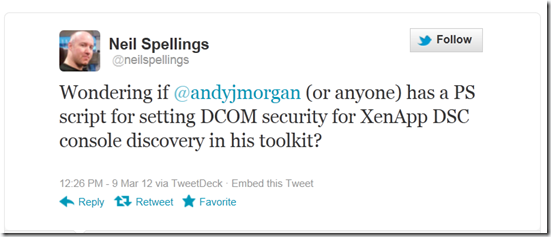![]() If you want to use the Delivery Services Console (the management console of Citrix XenApp 6.x) from a remote machine, you need to enable remote access in DCOM (as described in CTX131829).
If you want to use the Delivery Services Console (the management console of Citrix XenApp 6.x) from a remote machine, you need to enable remote access in DCOM (as described in CTX131829).
You can automate this via PowerShell using the script found below.
Set-RemotePermission-DCOM.ps1
PARAM(
[string]$Principal = $(throw "`nMissing -Principal DOMAIN\Group"),
$Computers = $(throw "`nMissing -Computers ('server01','server02')"))
# USAGE:
# .\Set-RemotePermission-DCOM.ps1 -Principal "DOMAIN\" -Computers ('', '',...)
#
# EXAMPLE:
# .\Set-RemotePermission-DCOM.ps1 -Principal "DOMAIN\LG-Citrix-Admins" -Computers ('CTX_DC001', 'CTX_DC002')
#
# Inspired by Karl Mitschke's post:
# https://unlockpowershell.wordpress.com/2009/11/20/script-remote-dcom-wmi-access-for-a-domain-user/
#
# And inspired Brad Turner's post:
# https://social.technet.microsoft.com/Forums/en-US/ilm2/thread/5db2707c-87c9-4bb2-a0eb-912363e2814a/
function get-sid
{
PARAM ($DSIdentity)
$ID = new-object System.Security.Principal.NTAccount($DSIdentity)
return $ID.Translate( [System.Security.Principal.SecurityIdentifier] ).toString()
}
$sid = get-sid $Principal
#DefaultLaunchPermission - Local Launch, Remote Launch, Local Activation, Remote Activation
$DCOMSDDLDefaultLaunchPermission = "A;;CCDCLCSWRP;;;$sid"
#DefaultAccessPermision - Local Access, Remote Access
$DCOMSDDLDefaultAccessPermision = "A;;CCDCLC;;;$sid"
#PartialMatch
$DCOMSDDLPartialMatch = "A;;\w+;;;$sid"
foreach ($strcomputer in $computers)
{
write-host "`nWorking on $strcomputer with principal $Principal ($sid):"
# Get the respective binary values of the DCOM registry entries
$Reg = [WMIClass]"\\$strcomputer\root\default:StdRegProv"
$DCOMDefaultLaunchPermission = $Reg.GetBinaryValue(2147483650,"software\microsoft\ole","DefaultLaunchPermission").uValue
$DCOMDefaultAccessPermission = $Reg.GetBinaryValue(2147483650,"software\microsoft\ole","DefaultAccessPermission").uValue
# Convert the current permissions to SDDL
write-host "`tConverting current permissions to SDDL format..."
$converter = new-object system.management.ManagementClass Win32_SecurityDescriptorHelper
$CurrentDCOMSDDLDefaultLaunchPermission = $converter.BinarySDToSDDL($DCOMDefaultLaunchPermission)
$CurrentDCOMSDDLDefaultAccessPermission = $converter.BinarySDToSDDL($DCOMDefaultAccessPermission)
# Build the new permissions
if (($CurrentDCOMSDDLDefaultLaunchPermission.SDDL -match $DCOMSDDLPartialMatch) -and ($CurrentDCOMSDDLDefaultLaunchPermission.SDDL -notmatch $DCOMSDDLDefaultLaunchPermission))
{
$NewDCOMSDDLDefaultLaunchPermission = $CurrentDCOMSDDLDefaultLaunchPermission.SDDL -replace $DCOMSDDLPartialMatch, $DCOMSDDLDefaultLaunchPermission
}
else
{
$NewDCOMSDDLDefaultLaunchPermission = $CurrentDCOMSDDLDefaultLaunchPermission.SDDL + "(" + $DCOMSDDLDefaultLaunchPermission + ")"
}
if (($CurrentDCOMSDDLDefaultAccessPermission.SDDL -match $DCOMSDDLPartialMatch) -and ($CurrentDCOMSDDLDefaultAccessPermission.SDDL -notmatch $DCOMSDDLDefaultAccessPermision))
{
$NewDCOMSDDLDefaultAccessPermission = $CurrentDCOMSDDLDefaultAccessPermission.SDDL -replace $DCOMSDDLPartialMatch, $DCOMSDDLDefaultAccessPermision
}
else
{
$NewDCOMSDDLDefaultAccessPermission = $CurrentDCOMSDDLDefaultAccessPermission.SDDL + "(" + $DCOMSDDLDefaultAccessPermision + ")"
}
# Convert SDDL back to Binary
write-host "`tConverting SDDL back into binary form..."
$DCOMbinarySDDefaultLaunchPermission = $converter.SDDLToBinarySD($NewDCOMSDDLDefaultLaunchPermission)
$DCOMconvertedPermissionDefaultLaunchPermission = ,$DCOMbinarySDDefaultLaunchPermission.BinarySD
$DCOMbinarySDDefaultAccessPermission = $converter.SDDLToBinarySD($NewDCOMSDDLDefaultAccessPermission)
$DCOMconvertedPermissionsDefaultAccessPermission = ,$DCOMbinarySDDefaultAccessPermission.BinarySD
# Apply the changes
write-host "`tApplying changes..."
if ($CurrentDCOMSDDLDefaultLaunchPermission.SDDL -match $DCOMSDDLDefaultLaunchPermission)
{
write-host "`t`tCurrent DefaultLaunchPermission matches desired value."
}
else
{
$result = $Reg.SetBinaryValue(2147483650,"software\microsoft\ole","DefaultLaunchPermission", $DCOMbinarySDDefaultLaunchPermission.binarySD)
if($result.ReturnValue='0'){write-host " Applied DefaultLaunchPermission complete."}
}
if ($CurrentDCOMSDDLDefaultAccessPermission.SDDL -match $DCOMSDDLDefaultAccessPermision)
{
write-host "`t`tCurrent DefaultAccessPermission matches desired value."
}
else
{
$result = $Reg.SetBinaryValue(2147483650,"software\microsoft\ole","DefaultAccessPermission", $DCOMbinarySDDefaultAccessPermission.binarySD)
if($result.ReturnValue='0'){write-host " Applied DefaultAccessPermission complete."}
}
}
#----------------------------------------------------------------------------------------------------------
trap
{
$exMessage = $_.Exception.Message
if($exMessage.StartsWith("L:"))
{write-host "`n" $exMessage.substring(2) "`n" -foregroundcolor white -backgroundcolor darkblue}
else {write-host "`nError: " $exMessage "`n" -foregroundcolor white -backgroundcolor darkred}
Exit
}
#----------------------------------------------------------------------------------------------------------
Download
Set-RemotePermission-DCOM.ps1
Usage
.\Set-RemoteAccess-DCOM.ps1 -Principal Contoso\LG-Citrix Admins" -Computers 'LocalHost'
.\Set-RemoteAccess-DCOM.ps1 -Principal Contoso\LG-Citrix Admins" -Computers 'CTX_DC001'
.\Set-RemoteAccess-DCOM.ps1 -Principal Contoso\LG-Citrix Admins" -Computers ('CTX_DC001', 'CTX_DC002')
PS: The script is based on the script found in this technet forum post.
As requested by Neil Spelling:

It’s a pleasure to find someone who can identify the issues so clearly